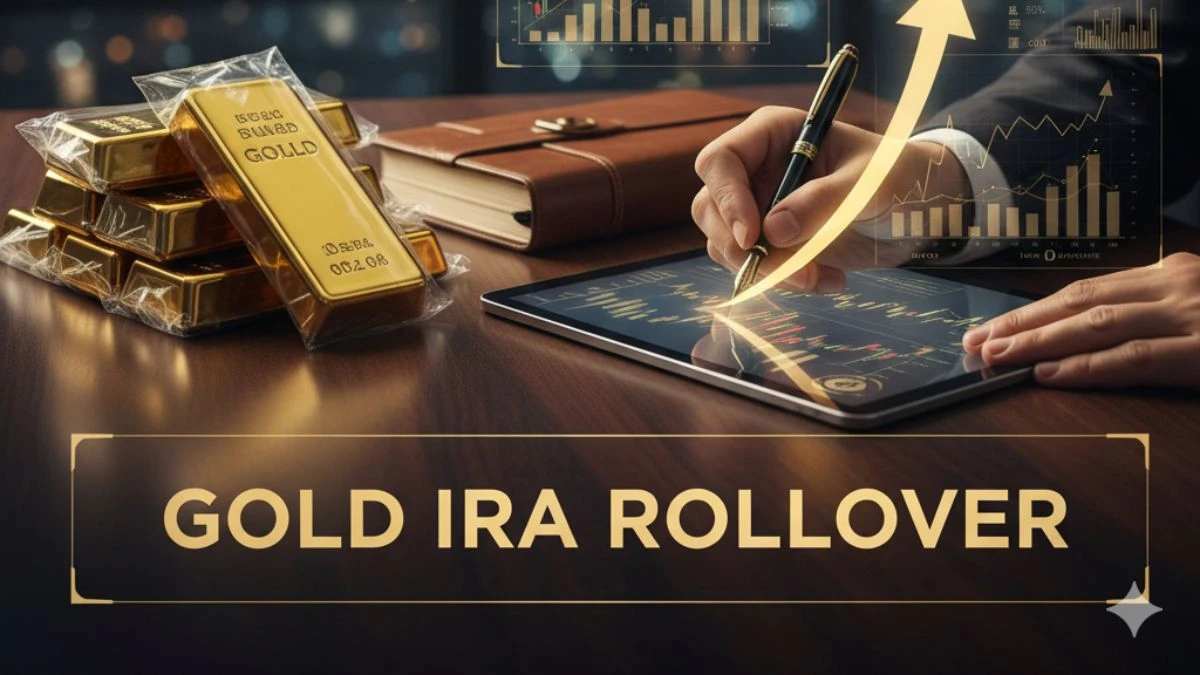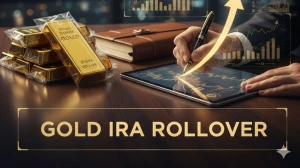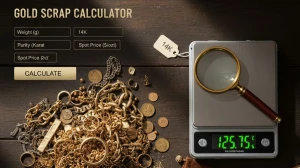
Gold IRA Rollover Guide 2025: How to Transfer Your Retirement Account to Physical Gold
Complete Gold IRA rollover guide 2025: Learn how to transfer your 401(k) or traditional IRA to physical gold tax-free, IRS-approved metals, custodian selection, and step-by-step process.
by Admin
Published Oct 23, 2025 | Updated Oct 23, 2025 | 📖 7 min read
A Gold IRA rollover is the process of transferring funds from an existing retirement account—such as a traditional IRA, Roth IRA, or 401(k)—into a self-directed IRA that holds physical gold and other precious metals. This strategy allows investors to diversify their retirement portfolio beyond stocks and bonds, providing a hedge against inflation, currency devaluation, and economic uncertainty.
In this comprehensive guide, we'll walk you through everything you need to know about Gold IRA rollovers in 2025: the IRS rules, eligible metals, tax implications, step-by-step process, custodian selection, and common mistakes to avoid.
What Is a Gold IRA?
A Gold IRA (Individual Retirement Account) is a self-directed retirement account that allows you to invest in physical precious metals instead of traditional paper assets. Unlike conventional IRAs that hold stocks, bonds, or mutual funds, a Gold IRA holds IRS-approved physical gold, silver, platinum, and palladium bullion or coins.
Key characteristics of a Gold IRA:
- Physical ownership: You own actual gold bars or coins, not gold stocks or ETFs
- IRS-approved storage: Metals must be stored in an approved depository (not at home)
- Tax advantages: Same tax benefits as traditional or Roth IRAs
- Self-directed: You control the investment decisions
- Diversification: Portfolio protection beyond traditional assets
Why Consider a Gold IRA Rollover in 2025?
Investors are increasingly turning to Gold IRAs for several compelling reasons:
1. Inflation Hedge
Gold has historically maintained purchasing power during periods of high inflation. With the U.S. inflation rate fluctuating and central banks printing money, physical gold provides protection against currency devaluation.
2. Portfolio Diversification
Financial advisors typically recommend allocating 5-15% of retirement portfolios to precious metals. Gold has a low correlation with stocks and bonds, reducing overall portfolio volatility.
3. Economic Uncertainty
Geopolitical tensions, banking crises, and stock market volatility drive investors toward safe-haven assets. Gold has served as a store of value for 5,000+ years.
4. Tax-Advantaged Growth
Gold IRAs offer the same tax benefits as traditional IRAs: tax-deferred growth (traditional) or tax-free growth (Roth), allowing your precious metals investment to compound without annual tax burdens.
5. Dollar Weakness
As the U.S. dollar faces pressure from rising national debt ($34+ trillion) and geopolitical shifts, gold priced in dollars tends to appreciate.
Gold IRA Rollover vs. Transfer: What's the Difference?
Understanding the distinction is crucial for avoiding IRS penalties:
| Feature | Rollover | Transfer |
|---|---|---|
| Process | Funds sent to you, then deposited to new IRA | Direct custodian-to-custodian transfer |
| Time Limit | 60 days to complete deposit | No time limit |
| Tax Withholding | 20% withheld (if 401(k) rollover) | No withholding |
| Frequency Limit | Once per 12 months | Unlimited |
| Risk | Higher (miss deadline = taxes + penalty) | Lower (no tax exposure) |
| Recommended? | Only if necessary | Yes - preferred method |
Best Practice: Always opt for a direct transfer (custodian-to-custodian) rather than a rollover to avoid the 60-day deadline and potential tax complications.
IRS-Approved Precious Metals for Gold IRAs
Not all gold is eligible for IRA investment. The IRS has strict purity requirements:
Gold: Must be 99.5% pure (0.995 fineness)
- American Gold Eagle coins (exception: 91.67% purity allowed)
- Canadian Gold Maple Leaf coins
- Australian Gold Kangaroo coins
- Austrian Gold Philharmonic coins
- Gold bars from approved refiners (PAMP Suisse, Credit Suisse, etc.)
Silver: Must be 99.9% pure (0.999 fineness)
- American Silver Eagle coins
- Canadian Silver Maple Leaf coins
- Austrian Silver Philharmonic coins
- Silver bars from approved refiners
Platinum & Palladium: Must be 99.95% pure (0.9995 fineness)
- American Platinum Eagle coins
- Canadian Platinum Maple Leaf coins
- Bars from approved refiners
NOT Allowed: Collectible coins, numismatic coins, rare coins, jewelry, or gold held personally at home.
Step-by-Step Gold IRA Rollover Process
Step 1: Choose a Gold IRA Custodian
Select an IRS-approved custodian specializing in precious metals IRAs. Look for:
- Established reputation (10+ years in business)
- Transparent fee structure (setup, annual, storage)
- Excellent customer reviews and BBB rating
- Segregated storage options (your metals stored separately)
- Responsive customer support
Popular custodians include: Equity Trust, Kingdom Trust, Strata Trust, and specialized firms like Goldco, Augusta Precious Metals, and American Hartford Gold.
Step 2: Open Your Self-Directed Gold IRA
Complete the application with your chosen custodian. You'll provide:
- Personal identification (driver's license, Social Security number)
- Beneficiary information
- Funding source details (existing IRA or 401(k))
Step 3: Initiate the Rollover/Transfer
Your new custodian will handle the paperwork to contact your current IRA or 401(k) administrator. Choose:
- Direct Transfer (recommended): Funds move custodian-to-custodian
- Indirect Rollover: Check sent to you (must deposit within 60 days)
Step 4: Fund Your Gold IRA
Once funds arrive in your new self-directed IRA (typically 2-4 weeks), they'll be available for precious metals purchases.
Step 5: Select Your Precious Metals
Work with your custodian's metals dealer to choose IRS-approved gold, silver, platinum, or palladium. Consider:
- Mix of bullion coins and bars
- Diversification across metals (e.g., 70% gold, 20% silver, 10% platinum)
- Premiums over spot price (coins have higher premiums than bars)
Step 6: Secure Storage in Approved Depository
Your custodian will arrange shipment to an IRS-approved depository. Options include:
- Segregated storage: Your metals stored separately (higher fee, more security)
- Commingled storage: Your metals stored with others' (lower fee)
Top depositories: Delaware Depository, Brink's Global Services, International Depository Services (IDS).
Step 7: Manage and Monitor Your Account
Review your Gold IRA quarterly. You can buy additional metals, rebalance, or take distributions (after age 59½) without penalties.
Tax Implications of Gold IRA Rollovers
Tax-Free Rollover (if done correctly):
- Direct transfer from traditional IRA to Gold IRA: No taxes, no penalties
- 401(k) to Gold IRA rollover: No taxes if direct rollover completed
- Roth IRA to Roth Gold IRA: Tax-free and penalty-free
Tax Penalties to Avoid:
- Miss 60-day rollover deadline: Taxes + 10% early withdrawal penalty (if under 59½)
- Purchase non-approved metals: Treated as distribution (taxes + penalty)
- Store gold at home: IRS considers this a distribution (immediate taxes + penalty)
Required Minimum Distributions (RMDs):
Starting at age 73 (as of 2025), you must take RMDs from traditional Gold IRAs. You can either:
- Take in-kind distribution (receive physical gold)
- Sell metals and take cash distribution
Gold IRA Costs and Fees
Understanding fees is critical for long-term returns:
1. Setup Fee: $50-$300 (one-time)
2. Annual Custodian Fee: $75-$300/year (account maintenance)
3. Storage Fee: $100-$300/year (or 0.5-1% of metal value)
4. Transaction Fee: $40-$100 per purchase/sale
5. Metals Premium: 2-10% over spot price (dealer markup)
Example: For a $50,000 Gold IRA, expect total annual costs of $400-$800 (0.8-1.6% annually).
Common Gold IRA Rollover Mistakes to Avoid
1. Missing the 60-Day Deadline
If you receive a rollover check, you MUST deposit it within 60 days or face taxes and penalties. Use direct transfers instead.
2. Choosing the Wrong Custodian
Research thoroughly. Some custodians charge hidden fees or pressure you into high-premium numismatic coins.
3. Storing Gold at Home
IRS rules require IRA-held metals to be stored in approved depositories. Home storage Gold IRAs are illegal and will trigger taxes/penalties.
4. Buying Collectible Coins
Stick to IRS-approved bullion. Rare or collectible coins may not qualify and could be treated as prohibited transactions.
5. Ignoring Fees
High annual fees can erode returns. Compare custodian and storage fees carefully.
6. Over-Allocating to Gold
While gold is valuable for diversification, most advisors recommend 5-15% allocation. Don't put your entire retirement in precious metals.
Is a Gold IRA Rollover Right for You?
Consider a Gold IRA if you:
- Want portfolio diversification beyond stocks/bonds
- Are concerned about inflation or currency devaluation
- Seek a hedge against economic or geopolitical uncertainty
- Have a long-term investment horizon (5+ years)
- Understand the costs and storage requirements
Not ideal if you:
- Need liquidity (selling precious metals can take time)
- Seek high growth (gold doesn't pay dividends or interest)
- Are uncomfortable with price volatility
- Have a very small retirement account (fees may be disproportionate)
Conclusion: Take Control of Your Retirement with Gold
A Gold IRA rollover offers a powerful way to protect your retirement savings from inflation, diversify beyond traditional assets, and own tangible wealth. By understanding the IRS rules, choosing a reputable custodian, and following the step-by-step process, you can successfully transfer your 401(k) or IRA into physical gold—completely tax-free.
In 2025, with economic uncertainty and geopolitical tensions rising, many investors are turning to gold as a time-tested safe haven. Whether you're rolling over a small portion or a significant percentage of your retirement portfolio, a Gold IRA provides peace of mind and long-term wealth preservation.
Next Steps: Research top-rated Gold IRA custodians, request free guides and compare fee structures, consult a financial advisor or tax professional, and initiate your rollover with a trusted custodian.
FAQs - Gold IRA Rollover Guide 2025
. What is a Gold IRA rollover?
A Gold IRA rollover is the process of transferring funds from an existing retirement account (traditional IRA, Roth IRA, or 401(k)) into a self-directed IRA that holds physical gold and other IRS-approved precious metals. This allows you to diversify your retirement portfolio with tangible assets while maintaining tax-advantaged status.
. Is a Gold IRA rollover tax-free?
Yes, if done correctly. A direct transfer (custodian-to-custodian) from a traditional IRA to a Gold IRA is completely tax-free and penalty-free. For 401(k) rollovers, use a direct rollover to avoid the 20% withholding tax. You must complete indirect rollovers within 60 days to avoid taxes and penalties.
. What types of gold are allowed in a Gold IRA?
The IRS requires gold to be 99.5% pure (0.995 fineness). Approved options include American Gold Eagle coins (exception: 91.67% allowed), Canadian Gold Maple Leaf coins, Australian Gold Kangaroo coins, Austrian Gold Philharmonic coins, and gold bars from approved refiners like PAMP Suisse and Credit Suisse. Collectible or rare coins are not permitted.
. How long does a Gold IRA rollover take?
A typical Gold IRA rollover takes 2-4 weeks from initiation to completion. The timeline includes: opening your self-directed IRA (1-3 days), processing the transfer request (7-14 days), funds arriving in your new account (3-7 days), and purchasing and storing metals (3-5 days). Direct transfers are faster than indirect rollovers.
. Can I store Gold IRA metals at home?
No. IRS rules require all precious metals held in an IRA to be stored in an IRS-approved depository. Home storage Gold IRAs are illegal and will trigger immediate taxation and a 10% early withdrawal penalty if you're under age 59½. Use segregated or commingled storage at approved facilities like Delaware Depository or Brink's.
. What are the fees for a Gold IRA?
Gold IRA fees typically include: setup fee ($50-$300 one-time), annual custodian fee ($75-$300), storage fee ($100-$300 or 0.5-1% of metal value), transaction fees ($40-$100 per trade), and metals premiums (2-10% over spot price). For a $50,000 account, expect total annual costs of $400-$800 (0.8-1.6%).
. Can I roll over my 401(k) to a Gold IRA while still employed?
It depends on your employer's plan rules. Most 401(k) plans only allow rollovers after you leave your job (termination, retirement, or job change). However, some plans permit in-service distributions after age 59½. Check with your plan administrator. After leaving employment, you can roll over your entire 401(k) balance to a Gold IRA tax-free.
. How do I take distributions from a Gold IRA?
After age 59½, you can take penalty-free distributions from your Gold IRA in two ways: (1) In-kind distribution – receive physical gold shipped to your address, or (2) Cash distribution – your custodian sells the metals and sends you cash. Starting at age 73, you must take Required Minimum Distributions (RMDs) from traditional Gold IRAs annually.




